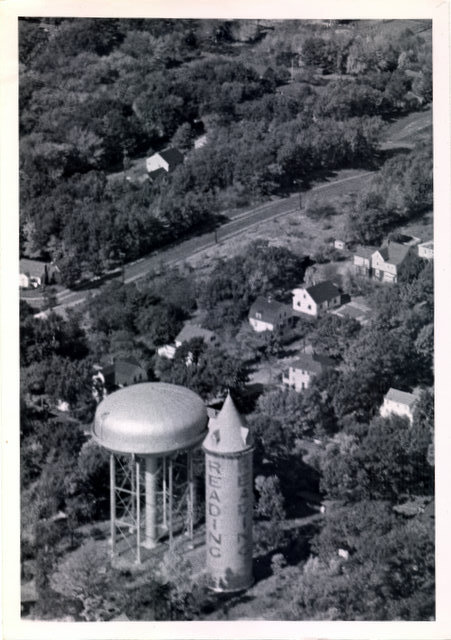Reading’s Water Tanks: Obsolete or Necessary?
Reading’s Water Quality & Supply Supervisor Fills Us In
From the Reading Historical Images collection at the RPL: “Auburn Street water towers,” Reading Public Library, Reading, Mass., accessed November 25, 2020, https://digitalheritage.noblenet.org/reading/items/show/4507.
November 25, 2020
As water towers play an important role in maintaining a safe hydraulic pressure in Reading’s water distribution system, the Auburn street tank which has exceeded its life expectancy will be replaced.
Reading’s water system currently consists of about 110 miles of piping and two water tanks: a standpipe on Bear Hill, and the more modern tower on Auburn Street. About 1.4 to 2.3 million gallons of water are used every day, flowing through about 9,000 homes. Historically, water towers have been essential to Reading’s water system, simply terminating their use would have major consequences. What exactly are the modern roles of these water towers then? Does the water inside of them, if there is any, ever actually run through the taps of Reading residents’ homes?
In an interview conducted over the phone, Erik Mysliwy, Reading’s water supply coordinator, was able to provide enlightening information on Reading’s water system and the significance of the two water tanks, which despite speculation, the town does actually still use. In the past, water would be processed at Reading’s water treatment plant and the tanks would be used for storage, feeding water into the town as necessary. Nowadays Reading purchases its water from the MWRA (Massachusetts Water Resources Authority). The current use of the tanks is no longer to store water really, but to create a “buffer or reserve to maintain regularity in pressure.”
So what does it take to maintain and preserve these huge tanks?
According to Mysliwy, the tanks require cleaning every 2-3 years, and every 5-10 years they need to be repainted–the Auburn street tank is currently in desperate need of this maintenance. Painting a water tower consists of many preparations and precautions; it also costs about 2.2 million dollars. Over time, sandblasting, which is necessary to remove any rust before painting, can thin the walls of the tower. The Auburn street tank can only withstand painting one more time.
Mysliwy explained that both the Bear Hill and Auburn street tank have exceeded their life expectancy. However, due to the fact that the Auburn street tank is centrally located and its anatomy is better for hydraulic pressure, only this tank will be replaced. Because Reading only needs a water tower for pressure regulation rather than storage there will no longer be a use for the Bear Hill tank. Mysliwy stated that because, “operationally, the tank is necessary, monetarily you are better off replacing it” than repainting it. This will cost about 4.5 million dollars which is worth it now rather than spending the 2.2 million to repaint the tank and then spending 4.5 million in 5-10 years when there is no option but to replace it.
The town will go about replacing the Auburn street tank by using only the Bear Hill tank while the new Auburn street tank is installed and then completely decommissioning the Bear Hill tank. This new tank will consist of an outer layer of concrete and an inner layer of glass which will require no maintenance at all. With the decommissioning of the Bear Hill tank and the elimination of the need for cleaning and painting of the new Auburn street tank, the town will also save lots of money. The life expectancy of this new tank is about 30-50 years, which is 30-50 years with no maintenance necessary.
Finally, Mysliwy touched upon the speculation of the addition of new cell towers to the site.
Because the tower is high above the ground it is a safe location for cellphone signal responders. Cell phone companies rent space on the tank for their signal responders. Because many people rely on their phones for communication, especially due to the fact that in recent years many people have gotten rid of their landlines, it is important that these responders are present during construction.
While the new Auburn street tank is being built, a temporary cell phone tower will be placed on the site. To address the speculation, Mysliwy confirmed that this is as close as Reading is getting to a new cell phone tower. Once the new tank is completed the signal responders will be reattached to the tower, and there will be no additional responders added.
Because both the current Bear Hill and Auburn street tanks have exceeded their life expectancies, continuing to use them could be dangerous. If they were to fail, for any number of reasons that would come with their old age, there could be risks of water main bursts and irregular water pressure throughout the town.
It seems as if there will be large tanks overlooking the town from their perch on Auburn Street for a long time to come.
